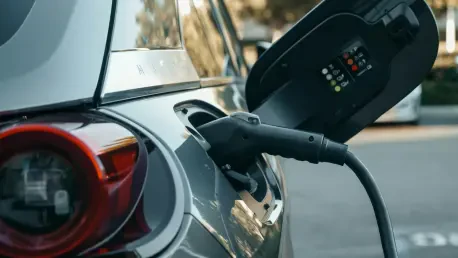In an era where technology and sustainability must converge to address pressing global challenges, a Nevada-based company is leading the charge by transforming used electric vehicle batteries into a powerful solution for the energy-hungry world of artificial intelligence. Redwood Materials, headquartered in Carson City, has emerged as a trailblazer in the climate tech sector by recycling critical battery materials and repurposing them into innovative microgrids. These small-scale power systems are designed to support AI data centers, which are notorious for their immense electricity demands. By harnessing solar energy and storing it in second-life EV batteries, this approach not only reduces environmental impact but also offers a scalable alternative to strained traditional grids. As the digital landscape continues to expand, the intersection of renewable energy and cutting-edge technology becomes ever more critical, positioning Redwood as a key player in shaping a greener, more efficient future.
Sustainable Innovation in Battery Recycling
Redwood Materials has carved a niche in the industry by focusing on the recovery of vital materials like lithium, nickel, and cobalt from used EV batteries, partnering with major automakers such as Volkswagen, BMW, and Toyota. This recycling process is far more than a waste management strategy; it slashes the carbon footprint by an impressive 70% compared to conventional mining methods. With mining often criticized for its invasive and resource-heavy nature, the ability to reuse these materials strengthens domestic supply chains and reduces reliance on environmentally damaging extraction. The significance of this cannot be overstated, especially as demand for critical minerals continues to soar with the proliferation of electric vehicles and renewable energy systems. By closing the loop on battery production, Redwood is paving the way for a circular economy that prioritizes sustainability without sacrificing technological progress, offering a model that could redefine resource management in the tech sector.
Beyond the environmental benefits, the strategic importance of Redwood’s work lies in its contribution to energy security and industrial resilience. As geopolitical tensions and supply chain disruptions highlight the vulnerabilities of relying on foreign mineral sources, localized recycling efforts become a national priority. The company’s operations help ensure a steady supply of essential components for new battery production, supporting the broader transition to clean energy. Moreover, the focus on reusing materials aligns with global climate goals to curb emissions and minimize ecological harm. While challenges remain, such as navigating market fluctuations and ensuring consistent battery supply, Redwood’s innovative recycling framework demonstrates a forward-thinking approach. This dual focus on environmental stewardship and strategic resource management positions the company as a leader in addressing some of the most pressing issues facing the tech and energy sectors today.
Microgrids as a Solution for AI Energy Demands
The rapid growth of AI technologies has brought with it an unprecedented surge in energy consumption, with data centers powering text, image, and video generation straining existing power infrastructures worldwide. Redwood Energy, a new branch of Redwood Materials, is tackling this challenge head-on by repurposing used EV batteries into microgrids that store solar power for localized energy needs. These batteries, often retaining significant chemical life for up to 20 years beyond their use in vehicles, provide an ideal second-life application. A pilot project in Nevada, utilizing 792 recycled batteries, has powered a small data center with over 99% efficiency, showcasing the potential of this technology. As AI’s energy demands are projected to nearly triple by 2028 according to recent Department of Energy estimates, such renewable solutions offer a timely alternative to fossil fuel dependency and grid overload.
Scaling this innovation, however, presents its own set of hurdles that must be navigated with precision. While the current microgrid serves a small facility effectively, the energy requirements of larger AI data centers, such as those planned by major tech companies, are exponentially greater—sometimes over 400 times the capacity of existing setups. Technical challenges also arise from integrating batteries of varying sizes and specifications from different manufacturers into a cohesive system. Redwood has made strides by developing universal connectors to ensure seamless swaps and grid stability, but the road to widespread adoption is complex. Despite these obstacles, the ability to deploy microgrids in roughly a year, compared to the much longer timelines for traditional grid expansions, underscores their potential. This balance of immediate impact and long-term scalability makes the technology a compelling piece of the puzzle in meeting AI’s voracious energy appetite sustainably.
Navigating Challenges and Future Growth
While Redwood Materials’ advancements are promising, the path forward is not without significant barriers that could impact the pace of progress. One key issue is the potential variability in EV battery supply, particularly if demand for electric vehicles wavers due to changes in subsidies or market dynamics in the US. Although partnerships with automakers like GM provide a buffer through non-binding agreements, economic or policy shifts could still disrupt the steady flow of materials needed for microgrid projects. Additionally, the sheer scale required to power massive data centers raises questions about feasibility, as current installations are dwarfed by the needs of industry giants planning gigawatt-scale facilities. These uncertainties highlight the importance of adaptability and strategic planning as Redwood seeks to expand its footprint in the energy landscape.
Looking ahead, Redwood is actively working to overcome these challenges by designing microgrids with ten times the capacity of initial installations, signaling ambitious growth plans. Securing long-term partnerships with automakers ensures a more reliable battery pipeline, while continued innovation in integration technology addresses compatibility issues. Although solar-powered microgrids alone cannot fully meet the colossal energy needs of AI, even partial coverage represents a meaningful step toward reducing reliance on non-renewable sources. The efforts made by Redwood Materials in the past to balance technological advancement with ecological responsibility set a precedent for the industry. By pushing the boundaries of what recycled materials can achieve, the company has helped lay the groundwork for a future where sustainable energy solutions are not just aspirational but actionable. Moving forward, expanding collaborations and refining scalable designs will be crucial next steps in solidifying this vision.









